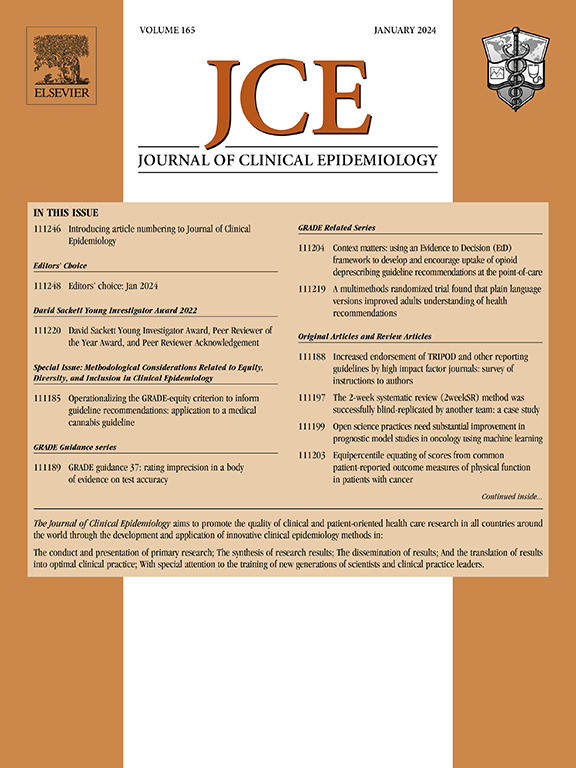试验损耗率的建模:对多种情况下药物干预的90个随机对照试验的个体参与者数据的分析。
IF 5.2
2区 医学
Q1 HEALTH CARE SCIENCES & SERVICES
引用次数: 0
摘要
试验损耗威胁随机对照试验(以下简称试验)的有效性,并对试验设计、实施和分析产生影响。很少有研究调查了流失率在随访中是如何变化的,也没有研究报告的流失率的类型。因此,我们使用一系列条件下的个体参与者数据来估计流失率。方法:我们获得了受试者在试验中花费的天数、完成情况和报告的未完成原因。为了与clinicaltrials.gov报告指南保持一致,我们将流失分类为:不良事件、缺乏疗效、失去随访、主要研究者/发起人决定、方案违反、自愿退出和其他。对于每个试验,我们估计了磨损的累积发生率,并拟合了六个参数时间到事件模型(指数、广义伽马、Gompertz、log-logistic、log-normal、Weibull)。采用赤池信息准则对拟合优度进行了图形化评价。从最佳拟合模型中获得每个试验的损耗率作为瞬时风险(即危险率)。结果:我们纳入了90项试验(86,107名参与者):2型糖尿病(45.6%),COPD(22.2%)和8种其他疾病(32.2%)。14,572名(16.9%)参与者出现了减员,在试验中从3.4%到43.7%不等。不良事件(43.5%)和自愿停药(24.1%)是最常见的消耗类型。Gompertz和对数正态时间-事件模型是最常见的最佳拟合模型。危险率通常在试验开始时达到峰值,之后下降。结论:磨耗率通常在试验开始时最高,之后下降,Gompertz和log-normal time-to-event模型很好地描述了这一点。这些发现可以为临床试验的设计、实施和分析提供信息。本文章由计算机程序翻译,如有差异,请以英文原文为准。
Modeling rates of trial attrition: an analysis of individual participant data from 90 randomized controlled trials of pharmacological interventions for multiple conditions
Background
Trial attrition threatens the validity of randomized controlled trials (hereafter trials) and has implications for trial design, conduct, and analysis. Few studies have examined how attrition rates change over follow-up or the types of attrition reported. Therefore, we estimated attrition rates using individual participant data for a range of conditions.
Methods
We obtained the number of days participants spent in trials, completion status, and reported reasons for noncompletion. For consistency with the clinicaltrials.gov reporting guidelines, we categorized attrition into adverse event, lack of efficacy, lost to follow-up, principal investigator/sponsor decision, protocol violation, voluntary withdrawal, and other. For each trial, we estimated the cumulative incidence of attrition and fitted six parametric time-to-event models (exponential, generalized gamma, Gompertz, log-logistic, log-normal, and Weibull). Goodness of fit was evaluated graphically and using the Akaike Information Criterion (AIC). Attrition rates were obtained for each trial as instantaneous risk (ie, hazard rates) from the best-fitting model.
Results
We included 90 trials (86,107 participants): type 2 diabetes (45.6%), chronic obstructive pulmonary disease (22.2%), and eight other conditions (32.2%). Attrition occurred for 14,572 (16.9%) participants, ranging from 3.4% to 43.7% among trials. Adverse event (43.5%) and voluntary withdrawal (24.1%) were the commonest categories of attrition. Gompertz and log-normal time-to-event models were the most frequent best-fitting models. Hazard rates typically peaked near the beginning of trials and decreased thereafter.
Conclusion
Attrition rates were generally highest near the beginning of trials, decreased thereafter, and were well-described by Gompertz and log-normal time-to-event models. These findings can inform the design, conduct, and analysis of clinical trials.
求助全文
通过发布文献求助,成功后即可免费获取论文全文。
去求助
来源期刊

Journal of Clinical Epidemiology
医学-公共卫生、环境卫生与职业卫生
CiteScore
12.00
自引率
6.90%
发文量
320
审稿时长
44 days
期刊介绍:
The Journal of Clinical Epidemiology strives to enhance the quality of clinical and patient-oriented healthcare research by advancing and applying innovative methods in conducting, presenting, synthesizing, disseminating, and translating research results into optimal clinical practice. Special emphasis is placed on training new generations of scientists and clinical practice leaders.
 求助内容:
求助内容: 应助结果提醒方式:
应助结果提醒方式:


